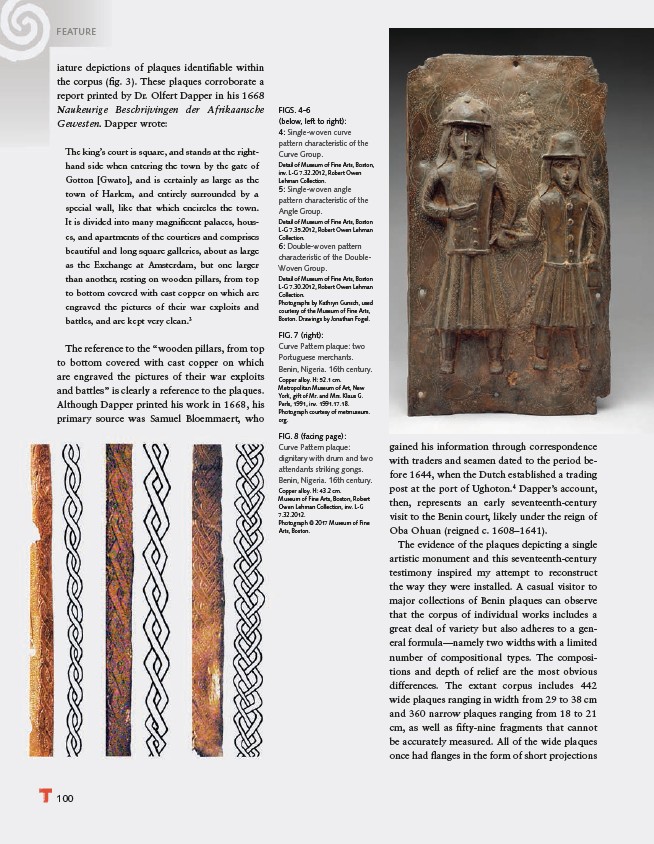
FEATURE
100
FIGS. 4–6
(below, left to right):
4: Single-woven curve
pattern characteristic of the
Curve Group.
Detail of Museum of Fine Arts, Boston,
inv. L-G 7.32.2012, Robert Owen
Lehman Collection.
5: Single-woven angle
pattern characteristic of the
Angle Group.
Detail of Museum of Fine Arts, Boston
L-G 7.35.2012, Robert Owen Lehman
Collection.
6: Double-woven pattern
characteristic of the Double-
Woven Group.
Detail of Museum of Fine Arts, Boston
L-G 7.30.2012, Robert Owen Lehman
Collection.
Photographs by Kathryn Gunsch, used
courtesy of the Museum of Fine Arts,
Boston. Drawings by Jonathan Fogel.
FIG. 7 (right):
Curve Pattern plaque: two
Portuguese merchants.
Benin, Nigeria. 16th century.
Copper alloy. H: 52.1 cm.
Metropolitan Museum of Art, New
York, gift of Mr. and Mrs. Klaus G.
Perls, 1991, inv. 1991.17.18.
Photograph courtesy of metmuseum.
org.
FIG. 8 (facing page):
Curve Pattern plaque:
dignitary with drum and two
attendants striking gongs.
Benin, Nigeria. 16th century.
Copper alloy. H: 43.2 cm.
Museum of Fine Arts, Boston, Robert
Owen Lehman Collection, inv. L-G
7.32.2012.
Photograph © 2017 Museum of Fine
Arts, Boston.
iature depictions of plaques identifi able within
the corpus (fi g. 3). These plaques corroborate a
report printed by Dr. Olfert Dapper in his 1668
Naukeurige Beschrijvingen der Afrikaansche
Gewesten. Dapper wrote:
The king’s court is square, and stands at the righthand
side when entering the town by the gate of
Gotton Gwato, and is certainly as large as the
town of Harlem, and entirely surrounded by a
special wall, like that which encircles the town.
It is divided into many magnifi cent palaces, houses,
and apartments of the courtiers and comprises
beautiful and long square galleries, about as large
as the Exchange at Amsterdam, but one larger
than another, resting on wooden pillars, from top
to bottom covered with cast copper on which are
engraved the pictures of their war exploits and
battles, and are kept very clean.3
The reference to the “wooden pillars, from top
to bottom covered with cast copper on which
are engraved the pictures of their war exploits
and battles” is clearly a reference to the plaques.
Although Dapper printed his work in 1668, his
primary source was Samuel Bloemmaert, who
gained his information through correspondence
with traders and seamen dated to the period before
1644, when the Dutch established a trading
post at the port of Ughoton.4 Dapper’s account,
then, represents an early seventeenth-century
visit to the Benin court, likely under the reign of
Oba Ohuan (reigned c. 1608–1641).
The evidence of the plaques depicting a single
artistic monument and this seventeenth-century
testimony inspired my attempt to reconstruct
the way they were installed. A casual visitor to
major collections of Benin plaques can observe
that the corpus of individual works includes a
great deal of variety but also adheres to a general
formula—namely two widths with a limited
number of compositional types. The compositions
and depth of relief are the most obvious
differences. The extant corpus includes 442
wide plaques ranging in width from 29 to 38 cm
and 360 narrow plaques ranging from 18 to 21
cm, as well as fi fty-nine fragments that cannot
be accurately measured. All of the wide plaques
once had fl anges in the form of short projections